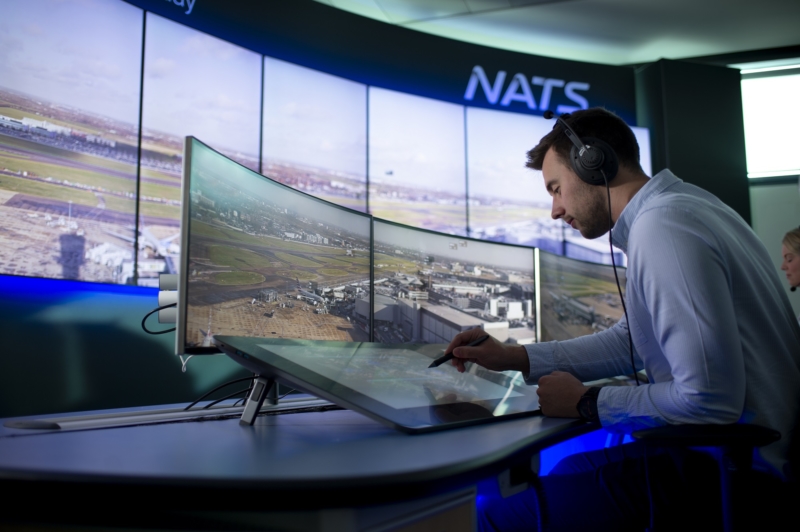Since the days of the first control tower 100 years ago – complete with its flags and lamps – airport air traffic control has followed one very simple principle – see aircraft, control aircraft.
But as airports have grown in size over the century, it’s become more and more difficult to give the air traffic controllers the best possible view of the airfield. Towers have become taller and more elaborate, but when a taxiway or runway threshold can be several kilometres away from the tower, getting a perfect view is genuinely difficult. In some cases, this has led to airports with multiple control towers, each housing separate functions
So what about bringing the view to the controller?
If you can put an array of cameras at strategic locations around an airfield – taxiways, runway exits points etc – then there is no reason why each controller cannot have his or her own enhanced personalised view, dedicated to whatever role they’re currently fulfilling, and brought close up to them while still keeping the team of controllers together, enabling direct coordination.
This is just one of the kinds of innovations we’re exploring in our Digital Tower Laboratory located in the base of the physical tower at Heathrow as part of a much wider revolution in how air traffic control is provided at airports.

A decade ago, digital towers were a niche concept, confined to a small part of the industry. Fast forward to today and they are now an operational reality for a growing number of airports around the world. From London to Singapore via Budapest and Colorado, airports of all sizes and types are either going ‘digital’ or on the verge of doing so.
Initially, the attraction of digital tower technology was the chance to use cameras and high-speed data connections to allow controllers to move offsite to another location, sometimes hundreds of kilometres away, just like we have done with radar control for many years. Where an airfield if geographically remote and traffic levels low, or where space is at an absolute premium, this has an obvious appeal. But what we’re discovering now is that the potential of this technology far greater.
The real transformative power of digital tower technology lies in using it to augment and improve an existing operation and that is what we’ve been working on with Searidge Technologies over the past two years.
Working together in the Digital Tower Laboratory, we are developing tools and concepts designed to enhance the operational service the controllers can deliver, having recognised that we have now reached the limits of human performance in terms of task load/traffic levels and safety.
By bringing the development space within touching distance of the live operational environment means we are benefiting from using real data as part of our work, while the controllers can feed their insights into us directly as we’re building concepts and validating prototypes; reducing the typical development and deployment cycle from years to a matter of months. And working closely with the airport means we can direct our energy towards addressing very specific problems.

On around 15-20 days a year, Heathrow’s 87 metre–high tower can disappear into low cloud, meaning the controllers cannot see the runways and taxiways, despite conditions being clear at ground level. In these conditions, the controllers rely on radar alone, reducing situational awareness and increasing workload and which leads to an approximately 20% reduction in the landing rate in order to maintain safe operations in such circumstances.
Over the past year we’ve been testing whether a distributed network of cameras, placed around the runway exit points, together with Searidge Technology’s Artificial Intelligence (AI) platform AIMEE, which then interprets those images and alerts the controllers, can be used to provide controllers with support in monitoring the operation and providing prompts to enhance awareness and safety.. and to help get that lost capacity back, when it’s needed.
This isn’t about replacing the controller but recognising that there are some things AI can simply do that either a person can’t or would find very difficult. A controller could never simultaneously monitor every one of an airport’s dozens of runway entry/exit points, let alone every part of the manoeuvring area, but AI can, and it can do it every second of every minute of every hour of every day. What we are striving for is human and technology working together in harmony… and with greater efficiency and safety.
The point I’m making is that a digital tower can be whatever an airport operation needs it to be, from the international hub through to the small, but vital remote island airfield, and we are all missing a trick if we limit our thinking. It’s for that reason that I believe, as an ex-controller, that Digital Towers provide the greatest potential leap forward we’ve ever made in airport air traffic control.
Comments
Please respect our commenting policy and guidelines when posting on this website.

31.07.2020
19:16
mike Owens
Surly the need for ATC in the first place was the biggest innovation? so can it not be argued that ICAO is the innovation that has had the biggest impact. Just a thought.
22.02.2021
18:35
Cleve Francoeur
Come a long way, in 1956 I graduated from military atc school, where we walked around the room with little aircraft in our hands and the student inside a little box with a loudspeaker telling us what to do